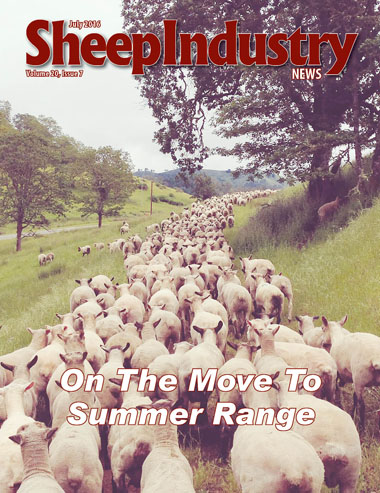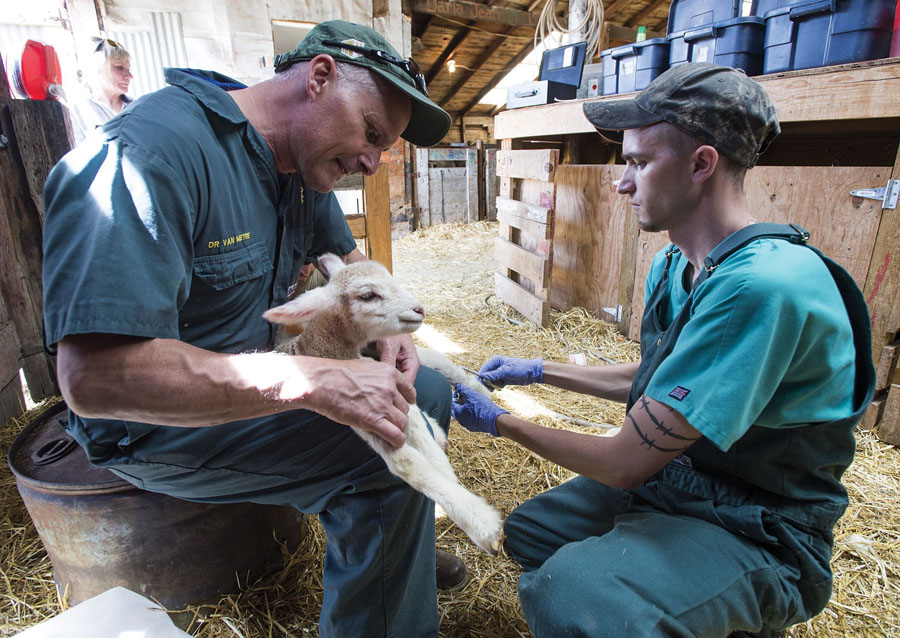
- July 2016
- President’s Notes
- Yellowstone Menus Offer Lamb
- ASI Comments on Behalf of USSES
- ASI Photo Contest
- Industry Recommends Research Priorities
- Sheep Center Sets Grant Deadline
- Sale Strengthens Lempriere
- Appropriations Update from Washington, D.C.
- Guaranteed for Life
- Young Entrepreneur: Sarah Spear
- CSU Vet Team Works Wyoming Ranch
- NSIP Offers Producers Online Tools
- Obituary
- Market Report
- Around the States
- The Last Word
CSU Vet Team Works Wyoming Ranch
Students Gain Experience With Real-World Lambing
COLEMAN CORNELIUS
CSU College of Veterinary Medicine and Biomedical Sciences
Six doctors and a nurse strode under the “Hospital” sign into the maternity ward, then to the neonatal intensive care unit, where a dozen babies were bawling for attention. Make that bleating.
The newborns had a variety of life-threatening problems: diarrhea, hypothermia, inadequate oxygen at birth, infectious disease, limb abnormalities, low blood sugar and pneumonia, among them.
 As the medical team began treating patients – examining, diagnosing and administering drugs and fluids – a customized pickup pulled into the hospital bay. The “lambulance” had arrived. A Peruvian sheepherder jumped out to deliver another group of ewes and newborn lambs to the sprawling red barn.
As the medical team began treating patients – examining, diagnosing and administering drugs and fluids – a customized pickup pulled into the hospital bay. The “lambulance” had arrived. A Peruvian sheepherder jumped out to deliver another group of ewes and newborn lambs to the sprawling red barn.
These were among the last of nearly 4,000 ewes and about 7,000 newborns to pass through the low-slung barn during lambing season this spring. Among the last to be assessed and treated by a Colorado State University veterinary team that has returned each spring for nearly 20 years to this historic Wyoming sheep ranch. The reciprocal arrangement provides rising veterinarians with vital training, and mothers and babies with vital care.
“This is a perinatology clinic,” explained Dr. David Van Metre, a CSU professor of livestock medicine and surgery, referring to the time around birth when the health of both ewes and newborns is a concern. “Whenever you have 4,000 mothers giving birth, you’re going to have a range of illness in some of the ewes and lambs. This gives our students hands-on experience managing those cases.”
A clinic in a truck
Practicing medicine here – miles from the nearest paved road – is different than at CSU’s James L. Voss Veterinary Teaching Hospital, with its leading-edge diagnostic equipment and dozens of board-certified specialists. Here, in a food-animal production setting, a veterinarian teases life from death relying on his or her own knowledge and the tools on his or her truck.
That includes duct tape, as two veterinary trainees soon proved when splinting the congenitally deformed leg of a lamb with contracted tendons. The splint, ending with a duct-tape bootie, would encourage the tendons to stretch and the lamb’s bowed leg to move normally.
“When he spun the genetic wheel, he didn’t win. He didn’t go bankrupt, he just didn’t go to Hawaii,” veterinary student Dalton Hindmarsh joked with his teammate, Lindsey Branscom, as they injected the lamb with an anti-inflammatory and pain medication. The joke had a realistic underpinning: A lamb with musculoskeletal problems can fall behind the flock, becoming vulnerable to abandonment and predation by coyotes.
It was early May and the final day of a yearly lambing practicum, an elective field rotation for seniors in the CSU Doctor of Veterinary Medicine Program. In just one week, the students in this session would graduate from veterinary school and transition into medical careers.
But now the young veterinarians were a world away, on a rolling prairie north of Cheyenne. The Medicine Bow Mountains were a jagged mirage to the west. The team worked in barns tucked into a draw on historic ranchland owned by Warren Livestock Company, the fabled cattle and sheep operation founded in 1883 by Francis E. Warren, a territorial governor, the first elected governor of Wyoming and a U.S. senator for 37 years.
Nurturing lambs – and a ranch
In the late 1800s, Warren ran sheep from Casper, in central Wyoming, nearly to Greeley and Fort Collins in northern Colorado. In the 1930s, Warren Ranch, working with John Hill, dean of agriculture at the University of Wyoming, even developed its own breed of white-faced sheep – the Warhill, a mix of Rambouillet, Columbia and other bloodlines – a breed known for producing twins and quality fleece.
In supporting the health of today’s ewes and lambs, the CSU veterinary team was also nurturing the legacy and current operations of Warren Ranch, now owned by Doug and Susan Samuelson.
Yet Van Metre, the livestock professor, and student Dave Williams were more immediately concerned with a lamb displaying symptoms of birth hypoxia, or oxygen deprivation. Weighing perhaps 7 pounds, the little creature was dull and weak. Williams methodically examined the lamb.
“What do you want to do, doc?” Van Metre asked Williams, as they knelt on the barn floor.
“He needs nutritional support, so let’s tube him with colostrum,” the new veterinarian responded, as Van Metre nodded. They hoped the nutrient-rich first milk – a catch-all remedy – would revive the lamb, allowing it to stand, nurse and progress normally to range life along with the other sheep in the barn. “I’ll check his blood glucose to see how we’re doing.”
Life-and-death decisions
Down the barn aisle, another veterinary team evaluated a more difficult case. A ewe had lambed overnight and, once trucked to the barn, was lethargic and not eating. Two veterinary students, a resident and technician had first surmised that the ewe might be carrying another lamb. Branscom, who grew up on a ranch, vaginally palpated the ewe; but instead of a lamb, the student found dark, malodorous blood, a sign of uterine infection.
Jeruesha Nichols, an experienced veterinary technician, exhaled. “That’s not good news,” she said quietly. Even worse, the ewe’s gums were pale, and she shivered slightly – signs of shock from blood loss. The four agreed: It was time to determine whether the ewe had suffered a tear in her uterus, an injury that would cause internal bleeding, infection and sure death for a range animal.
Student Dana Powers readied a needle and syringe, then tapped the ewe’s abdomen. Blood gushed into the chamber. The abdominocentesis confirmed it: The ewe was bleeding internally, likely from a uterine rupture. The four were quiet for a moment, knowing what must come next.
“In this case, the prognosis is grave,” Dr. Tanya Applegate, a veterinary resident, explained. “Humane euthanasia is the most ethical option.”
The procedure was quick and calm, an injected sedative, followed by a drug to stop the heart. Powers sat next to the ewe, stroking her foreleg and monitoring her heartbeat until her pulse slowed and stopped. It’s never easy, the nurse and young vet said, yet humane death may be the best option for an animal in pain, with no chance for recovery.
“To me, euthanasia can be one last gift,” Nichols said.
Powers nodded somberly. “We don’t do this because we’re cold,” she said. “We do it because we have empathy.”
Lamb gets the full treatment
Many other cases close on a brighter note, like that of Poke. “We’ve all gotten to know him,” said Hindmarsh, a talented young veterinarian raised on a fourth-generation sheep ranch in southwestern Colorado.
When he arrived as a newborn, Poke was diagnosed with radial nerve paralysis, which is caused by nerve damage and results in the inability to stand and walk. The lamb was treated with anti-inflammatories and even acupuncture, but just as the problem resolved Poke developed pneumonia. Antibiotics knocked out the lung infection. But infection arose again, this time in the lamb’s knee joints.
After a solid week of treatment for earlier problems, Poke was again completely lame. Hindmarsh took over the case and flushed the two septic joints with saline solution; he administered local anesthesia and other medication. Through the course of several days, Poke had progressed from immobility to a hobble to free movement in the pen with his mom.
“Each day, he’s gotten a little better, to the point that he’s running and jumping. He’s moving great,” said Hindmarsh.
Such confidence is exactly what Van Metre hopes the lambing rotation will instill in veterinary students as they prepare to launch careers. “They know more than they think they know. That’s the most rewarding thing for me,” he said.
Hindmarsh professed a love for production medicine, yet he planned to pursue a new passion for small-animal emergency veterinary care.
“A big sheep ranch,” he added, “that’s my retirement plan.”

